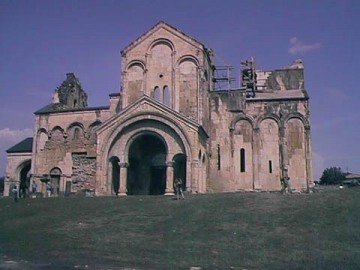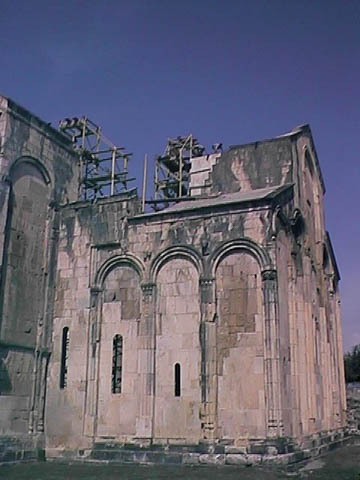Another day, so another location. Today we drive to Kutaisi, so we are up at 8.30 for breakfast. Today Steve did not eat, something to do with his stomach. Usual water stop at Borjomi. Then on to the M27. Today we had to pay a toll as we went through a 2km tunnel. Today we saw some men working on the road laying actual tarmac.

This road went through some hill areas, and suddenly we were in bee country. We had noticed in our travels, much of the trade was done by the road from cars and shacks. We also noticed that where there was one butcher, that there were ten butchers and nothing else. (A butcher was a place where they hung a dead animal and skinned it by the road.). There were areas where everyone was selling petrol out of cans by the road, or it was vegetables, or it was baskets. Well, now we were in bee country. There were hives and hives, all congregated around a house, there must have been twenty of these houses with their hives. Nino said it was a con, that there were no bees, and you were being sold coloured sugar water.
On our travels, we also noticed the school children. Everything in Georgia was rather dirty, a bit falling to pieces, but the school children were immaculate. Well dressed, gleaming white shirts, or ornate blouses, socks and shoes, and often black skirts with bands of white. The girl’s hair was ornately ribboned.
Somewhere along the road, we saw a huge iron alloy factory which was now deserted. There was now no market. The Soviets left and did not continue to buy from Georgia.
We stopped by some stalls selling craftwork, and we bought a huge carved wooden spoon, very plain but useful We also bought a wooden whisk, you used it by spinning it between the hands. It was used for stirring your beans.
At Ubisa we stopped to look at this charming little church. Built-in the 9th century. There were amazing 14th-century frescos including the annunciation of Christ. Nino said the brush strokes for the hair are individual and there are no pink cheeks, both of which are unusual. There were also some 16th-century frescos of St George. The torch was useful for viewing because there was no light.
Now it was on to Kutaisi and the Bagrati Cathedral, no roof and scary wood scaffolding. There was a wedding taking place.
Bagrati Cathedral
Bagrati Cathedral. It has no roof and is undergoing minor restoration to ensure it is safe. It was placed on the UNESCO World Heritage List.
Georgia is a funny place, iron is used very much more than we would use it. Most of the garden fences were made of iron, iron sheeting, or iron railings. We in the UK would use wood, or maybe brick.
When it comes to scaffolding, where we use metal, Georgia uses wood. The Cathedral of Bagrat is high in the Ukimerioni hill across the river from the city center. Some parts of the Cathedral are in quite a good nick. The Cathedral was destroyed by the Turks in 1691/92. Since then it has remained roofless.
Afternoon in Kutaisi
The afternoon was a free afternoon for us. Nino and Clare went off to do their own things. First, we had a picnic in the park. Us Brits sitting next to the fountain were in for a surprise when the power cut ended. Suddenly the fountain started and we all got wet.
We wondered around the market, many hat shops, numerous watch menders, and flower stalls. Again all congregated in areas.
We had a wander around the Kutaisi State Museum, everything was written in Georgian or Russian, so difficult to see what was on display. I think it was telling us the story of mankind in the Georgian area, first, there were the flint arrowheads, through to early telephone systems, weighing scales (one just like ours we use every day), Georgian waistcoats with cartridge holders. Problem with electricity here, they would not let us in, until the power cut was ended. But it was so dark anyway even when there was power.
We also found the Sports Museum. It was closed, tried again when the door was open, but the man said it was closed. We found some of the other tour members including Clare Eaton, the tour rep, and Ian White who could speak Russian, and Stuart Buckingham who was a Cricketer, and back we went to the museum.
Ian found out the place was closed until Monday. He explained we would not be around then. After much argument, we found the magic words, George Best’s shirt. Like magic, this let us in. Yes, there was a shirt from the 1969 Soviet Union – Ireland game from 1969 in Belfast. The museum was full of pictures and objects from Georgians sporting past. Georgia provided, (and especially Kutaisi), many of the team members for the Soviet teams. For example, in 1971 nine out of eleven team members of the Soviet team were Georgian, mostly from Kutaisi. Five out of eleven of the 1981 Dinamo Tbilisi team were from Kutaisi. There were skier and wrestling champions.
The snag with this tour was it was dark, with no light other than one inch of candle. The curator spoke rapid Russian, and Ian was able to translate a few words for us. Actually, it was quite a high light and hopefully has been put on the Explore Itinerary for the future.
After that, we went back to the coach, when the heavens opened and there were torrential rain and hail. Now on to the guest house, with the usual expensive-looking parquet flooring. Tiny kiosk outside to buy some beers. The Electricity was on and off all evening. For supper, we had: Vodka and homemade wine, along with the usual Georgian dishes.
Their six-year-old daughter came out to sing for us with a backing tape. very pretty and delicate green dress. We went to bed early, to be kept awake by the evening dog chorus, and woken early by the cockerels. Despite this being suburbia, we could see the odd cow being led through the gardens.


